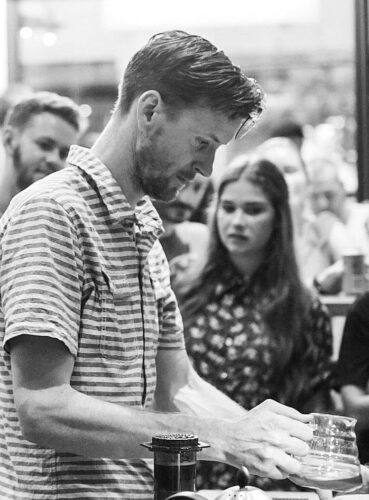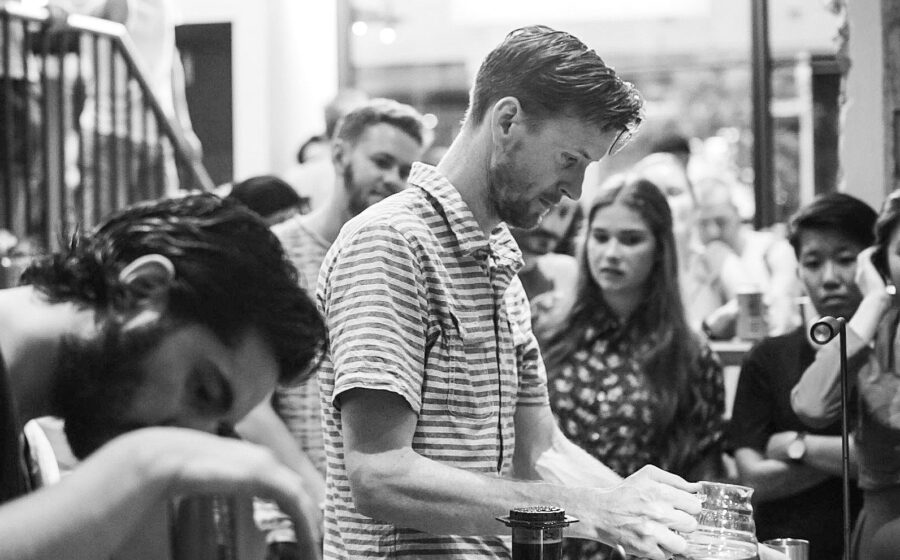[D]ylan Johnson, winner of the 2014 New South Wales and Australian AeroPress Championships, has been working in coffee for years now and currently serves as general manager for Paramount Coffee Project in Surry Hills, an inner-city suburb of Sydney. Of Paramount he says, “It’s a collaborative project to look at coffee differently in a café environment. We regularly cup coffee samples in order to serve a range of quality coffees from a variety of roasters, and host one-day and week-long residencies of coffee professionals from Australia and around the world.”
We asked Johnson over e-mail to talk about the AeroPress culture in New South Wales, his rise in coffee, and his philosophy of extraction.
You’ve been a barista since 2009, correct? How did you get into coffee, and what steps led you to your current champion status?
Yeah. Had a few café jobs previously, but got my first fulltime job in coffee in 2009. I think I got into coffee slowly over a few years. Most people I knew drank coffee and talked about what made a “good coffee.” There was a bit of pride to being able to do it well. So I got interested in making espresso. From there, like a lot of other baristas, it was a bit of a rabbit hole into discovering roast profiles, processing, and varieties. As I got further and further into it and discovered competition, I realized that coffee was something I could do for a living, and I wanted to. As for the competition stuff, I think I was lucky that I got into coffee through people who were very focused on quality but also focused on doing what they do the best they can. Watching competitions was a great way to see these people at work and learn and I had my first crack at competition in 2011. I’ve enjoyed doing competitions because they’ve helped me learn about coffee and experiment.
Can you fill us in on the rise in the AeroPress’s popularity in New South Wales? When did you begin seeing it used in cafés, and when did you start extracting coffee with it?
This year was the third year that the AeroPress competition has been run in NSW. But I can remember getting coffee brewed on an AeroPress at cafés about five years ago. I think they’ve long been popular for baristas but probably second to pour-over brewers like Hario and Kalita. I think it may have been the first brewer I bought, probably because it’s relatively cheap but also very easy to use, especially at home.
How did you prepare for the AeroPress Championship?
I looked at past winners’ methods and took a bit from each. But I think, initially, I started by trying use the AeroPress to mimic a cupping brew, but that didn’t work at all. The method I did use was a direct replication of our pour-over method. From there I compared sifting/non-sifting, temperatures, and dose. By changing these I aimed for a particular extraction and balance of flavor and that got me to the method I used.

We already know quite a bit about extraction from past research and coffee professionals, things like correct brew ratios, brewing temperatures, extraction yields, and strength. So the first principle would be start with what we know and get all of these variables right. From there we can experiment a little. This year at the NSW competition, we had twenty-seven competitors and they all had different methods. The AeroPress is a great brewer for its versatility. You can change a lot of variables in coffee brewing quite easily, for example time, temperature, agitation, dose. So with that in mind, experiment. Change one variable at a time and see what it gives you. I experimented first with dose then with temperature. But don’t forget about your water quality, some would argue it’s the most important ingredient to get right.
What coffees do you think work particularly well with the AeroPress and what are you currently enjoying prepared?
I’ve enjoyed some great Ethiopian and Kenyan coffees with the AeroPress. But I really think any coffee could be good if you give time to playing with the variables and manipulating them. The last coffee I put through the AeroPress was an Ethiopia Kochere, really clean, floral and bright.
Will you share a current brewing recipe with us?
Non-Inverted.
17.5 grams coffee, 250 grams water, 200 degrees Fahrenheit
Start timer, immediately add 65 grams water, stir gently, ensure all the coffee is wet.
At thirty seconds add sixty grams water, stir well.
At one minute, add 125 grams water, stir well, insert plunger (do not plunge).
At a minute and a half, start plunging. Stop with fifty grams of water still in AeroPress, discard. Aim to finish at two and a half minutes.
—Emily McIntyre is a regular contributor to Fresh Cup.
















